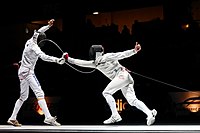
Back Skermsport Afrikaans مبارزة السلاح Arabic Esgrima AST Qılıncoynatma Azerbaijani Фехтование Bashkir Фехтаванне Byelorussian Фэхтаваньне BE-X-OLD Фехтовка Bulgarian Turai padang BJN གྲི་རྩེད། Tibetan
 Final of the Challenge Réseau Ferré de France–Trophée Monal 2012, épée world cup tournament in Paris | |
| Highest governing body | FIE |
|---|---|
| First played | Between the 17th and 19th centuries Europe |
| Characteristics | |
| Contact | Semi-contact |
| Team members | Singles or team relay |
| Mixed-sex | Yes, separate |
| Type | indoor |
| Equipment | Épée, foil, sabre, body cord, lamé, grip |
| Venue | Piste |
| Glossary | Glossary of fencing |
| Presence | |
| Country or region | Worldwide |
| Olympic | Part of Summer Olympic programme since 1896 |
| Paralympic | part of Summer Paralympic programme since 1960 |
 | |
| Also known as | Épée fencing, foil fencing, sabre fencing |
|---|---|
| Focus | Weaponry |
| Hardness | Semi-contact |
| Olympic sport | Present since inaugural 1896 Olympics |
| Official website | fie |
Fencing is a combat sport that features sword fighting.[1] The three disciplines of modern fencing are the foil, the épée, and the sabre (also saber); each discipline uses a different kind of blade, which shares the same name, and employs its own rules. Most competitive fencers specialise in one discipline. The modern sport gained prominence near the end of the 19th century and is based on the traditional skill set of swordsmanship. The Italian school altered the historical European martial art of classical fencing, and the French school later refined that system. Scoring points in a fencing competition is done by making contact with an opponent.
The 1904 Olympics Games featured a fourth discipline of fencing known as singlestick, but it was dropped after that year and is not a part of modern fencing. Competitive fencing was one of the first sports to be featured in the Olympics and, along with athletics, cycling, swimming, and gymnastics, has been featured in every modern Olympics.
- ^ "Fencing | History, Organizations, & Equipment | Britannica". www.britannica.com. 2024-01-19. Retrieved 2024-02-02.